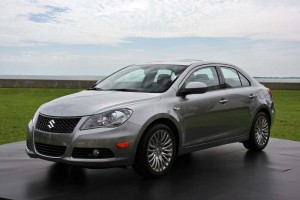
There's a lot riding on the new midsize 2010 Suzuki Kizashi, company officials promising it will bring "the complete transformation" of the Suzuki brand.
Few products have been asked to play such a significant role, but American Suzuki has a lot riding on the upcoming launch of its 2010 Kizashi sedan.
The Japanese maker has long been little more than a niche player in the critical U.S. market – even though it is now the world’s 11th largest automotive manufacturer. With the addition of the midsize Kizashi to its line-up, Suzuki is hoping to move into the mainstream. It’s an ambitious – some would say audacious – plan, with the Japanese automaker not only planning to take on big name brands, like Toyota, with its Camry, and Honda, with the Accord, but even some luxury marques, such as Acura.
“This product will complete the transformation of our brand,” said Gene Brown, American Suzuki’s vice president of marketing, during a preview of the 2010 Suzuki Kizashi. The sedan will also have to help reverse a sharp sales decline, among the worst among any brand competing in the American market.
In Japanese, Kizashi means “something great is coming,” and Suzuki put that message out when it first showed the sedan, in concept car form, at the September 2007 Frankfurt Motor Show. It reappeared, a half-year later, at the New York Auto Show. Now, Suzuki officials confirm the production version is due to hit showrooms by the end of 2009.
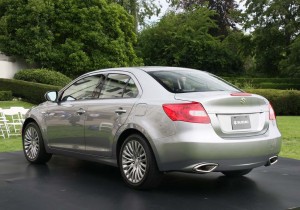
The 2010 Suzuki Kizashi isn't another "vanilla sleeping pill," suggested marketing chief Gene Brown, taking a shot at the Camry and Accord.
While they’re being cagey about details, they hint that the production Kizashi will fall into the heart of the midsize market, at least when it comes to price, which Steve Younan, director of product planning, defines as somewhere in the “high teens to the mid-$20,000” range.
For the money, a Kizashi buyer will get a four-door that’s a bit smaller, overall than either Accord or Camry, at 183 inches in total length, 72 inches and width, and with a 107-inch wheelbase. That’s roughly the same footprint as the new Volkswagen Passat or Volvo S60.
During their background briefing, American Suzuki officials were openly disdainful of mainstream competitors, such as Camry and Accord, which Brown dubbed “vanilla sleeping pills on wheels….soulless transportation appliances.”
Indeed, Kizashi has a bolder look, with an aggressive front end wrapped around the familiar egg crate Suzuki grille. The fenders flare out aggressively and the overall look is far more sporty than most entries into the staid midsize segment.
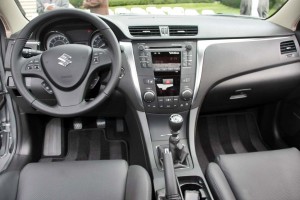
The interior of the 2010 Suzuki Kizashi is decidedly up-market from the automaker's earlier offerings, though Suzuki remains cautious about much of the latest tech features.
The interior is decidedly more up-market than one might expect, based on past Suzuki offerings, even with the base version of the 2010 Kizashi. The surfaces are carefully grained with refined touches like French seams and brushed chrome accents. Key instrumentation is organized within twin cylinders.
The new sedan will feature eight airbags and an advanced stability control system, noted product planner Eddie Rayan, that emphasizes sporty handling. In practice, that reportedly means being able to go into and out of tight turns more aggressively.
The powerplant on the 2010 Suzuki Kizashi will be a 2.4-liter I-4 making 185 hp, which company officials expect to be a best-in-segment. Eventually, says Kevin Saito, the new president of American Suzuki, a V-6 will be added, along with a hybrid powertrain, the latter based on a gasoline-electric drive system Suzuki plans to source from its long-time American affiliate, General Motors.
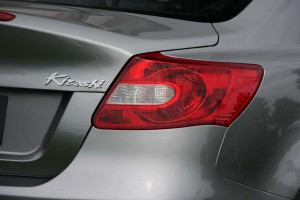
In Japanese, the name means "great things coming."
The I-4, meanwhile, will be mated to either a 6-speed manual or a Continuously Variable Transmission. CVTs offer a distinct improvement in fuel economy and though final numbers haven’t been calculated, Suzuki anticipated Kizashi, with the CVT, should deliver over 30 mpg on the highway. But the company has actually decided to accept a bit lower mileage than possible by electronically tuning the CVT to feel more like a conventional step-gear automatic. Paddle shifters can also be used, to effectively step through those virtual gears.
Kizashi will deliver a few high tech touches, including sonar-based rear parking assist and an optional rearview camera. The optional 425-watt Rockford Fosgate sound system, meanwhile, can be operated with a remote control and has a Bluetooth link to portable audio devices equipped with that feature.
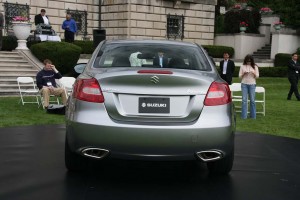
Sportier than the typical Japanese midsize sedan, the 2010 Suzuki Kizashi is targeting Euro offerings, like the new VW Passat, as well as more upscale near-luxury sedans.
But Suzuki decided against some other new features, such as a system to warn a motorist if there’s another car in their blind spot. “We found in our research that this was more annoying than helpful,” asserted Younan. Whether the decision not to engage in the latest round of tech warfare will hurt Suzuki remains to be seen.
There’s little doubt the Japanese maker must score a solid hit with Kizashi. Though company officials sidestepped questions about sales targets, they hinted that, over time, the sedan could grow into one, if not their biggest-seller. That would be much-appreciated, clearly, after the company eliminated its previous volume nameplate, the Forenza.
That and the decision to focus on more profitable retail markets, rather than fleets, has, at least for the moment, taken a serious toll. Suzuki sales are down about 60% so far this year from 2008 levels, when the automaker sold a total of 85,000 vehicles in the U.S. – giving it a market share of just 0.7%.
That’s miniscule compared to other parts of the world, where Suzuki has become a serious contender. In India, for example, where it was an early aspirant, it now holds a whopping 55% market share. In Japan, its Wagon R has been the country’s best-seller for four consecutive years. In 2008, Suzuki jumped to the 11th spot among global automakers, from 15th, the year before.
In the States, however, it was a late entrant and has been largely relegated to the small econobox segments, niches that are strong virtually everywhere but the U.S. There’d been some hope, at Suzuki, that products like the SX4 would gain ground when fuel prices soared to record levels, last year. But as TheDetroitBureau.com recently reported, small car sales have since fallen back to pre-oil crisis levels.
“Peoples’ underlying preferences didn’t shift,” acknowledges Brown, adding that while the maker “won’t stop making small cars,” it is counting on the 2010 Suzuki Kizashi to help it target new segments for growth in the American market.
